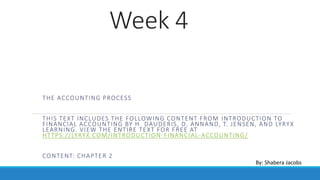
Week 4.pptx
- 1. Week 4 THE ACCOUNTING PROCESS THIS TEXT INCLUDES THE FOLLOWING CONTENT FROM INTRODUCTION TO FINANCIAL ACCOUNTING BY H. DAUDERIS, D. ANNAND, T. JENSEN, AND LYRYX LEARNING. VIEW THE ENTIRE TEXT FOR FREE AT HTTPS://LYRYX.COM/INTRODUCTION-FINANCIAL-ACCOUNTING/ CONTENT: CHAPTER 2 By: Shabera Jacobs
- 2. Introduction Chapter 2 looks more closely at asset, liability, and equity accounts and how they are affected by double- entry accounting, namely, debits and credits. The transactions introduced in the prior class for Big Dog Carworks Corp. are used to explain debit and credit analysis.
- 3. Objectives 1.Describe asset, liability, and equity accounts, identifying the effect of debits and credits on each. 2.Analyze transactions using double-entry accounting.
- 4. Asset Accounts Assets are resources that have future economic benefits for the business. The primary purpose of assets is that they be used in day-to-day operating activities in order to generate revenue either directly or indirectly. A separate account is established for each asset. Examples of asset accounts are reviewed below.
- 5. ASSETS Cash has future purchasing power. Coins, currency, cheques, and bank account balances are examples of cash. Accounts receivable occur when products or services are sold on account or on credit. When a sale occurs on account or on credit, the customer has not paid cash but promises to pay in the future. Notes receivable are a promise to pay an amount on a specific future date plus a predetermined amount of interest. Office supplies are supplies to be used in the future. If the supplies are used before the end of the accounting period, they are an expense instead of an asset.
- 6. ASSETS Cont’d Merchandise inventory are items to be sold in the future. Prepaid insurance represents an amount paid in advance for insurance. The prepaid insurance will be used in the future. Prepaid rent represents an amount paid in advance for rent. The prepaid rent will be used in the future. Land cost must be in a separate account from any building that might be on the land. Land is used over future periods. Buildings indirectly help a business generate revenue over future accounting periods since they provide space for day-to-day operating activities.
- 7. Liability Accounts A liability is an obligation to pay for an asset in the future. The primary purpose of liabilities is to finance investing activities that include the purchase of assets like land, buildings, and equipment. Liabilities are also used to finance operating activities involving, for example, accounts payable, unearned revenues, and wages payable. A separate account is created for each liability. Examples of liability accounts are reviewed below.
- 8. Liability Accounts Cont’d Accounts payable are debts owed to creditors for goods purchased or services received as a result of day-to-day operating activities. An example of a service received on credit might be a plumber billing the business for a repair. Wages payable are wages owed to employees for work performed. Short-term notes payable are a debt owed to a bank or other creditor that is normally paid within one year. Notes payable are different than accounts payable in that notes involve interest. Long-term notes payable are a debt owed to a bank or other creditor that is normally paid beyond one year. Like short-term notes, long-term notes involve interest. Unearned revenues are payments received in advance of the product or service being provided. In other words, the business owes a customer the product/service.
- 9. Equity Accounts Equity represents the net assets owned by the owners of a business. In a corporation, the owners are called shareholders. There are different types of equity accounts: share capital, retained earnings, dividends, revenues, and expenses. Share capital represents the investments made by owners into the business and causes equity to increase. Retained earnings is the sum of all net incomes earned over the life of the corporation to date, less any dividends distributed to shareholders over the same time period. Therefore, the Retained Earnings account includes revenues, which cause equity to increase, along with expenses and dividends, which cause equity to decrease.
- 10. Summary of equity accounts
- 11. T-accounts A simplified account, called a T-account, is often used as a teaching/learning tool to show increases and decreases in an account. It is called a T-account because it resembles the letter T.
- 14. Determining the account balance
- 15. The Chart of Accounts A business will create a list of accounts called a chart of accounts where each account is assigned both a name and a number. A common practice is to have the accounts arranged in a manner that is compatible with the order of their use in financial statements. For instance, Asset accounts begin with the digit ‘1’, Liability accounts with the digit ‘2’. Each business will have a unique chart of accounts that corresponds to its specific needs. Big Dog Carworks Corp. uses the following numbering system for its accounts:
- 16. Chart of Accounts Cont’d Big Dog Carworks Corp. uses the following numbering system for its accounts:
- 17. Transaction Analysis Using Accounts Transactions for Big Dog Carworks Corp will be used to demonstrate double-entry accounting. Double- entry accounting means each transaction is recorded in at least two accounts where the total debits ALWAYS equal the total credits. As a result of double- entry accounting, the sum of all the debit balance accounts in the ledger must equal the sum of all the credit balance accounts.
- 18. The rule that debits = credits is rooted in the accounting equation: Assets = Liabilities + Equity Increases are debits credits credits Decreases are credits debits debits